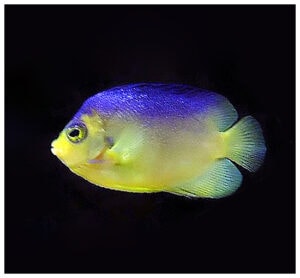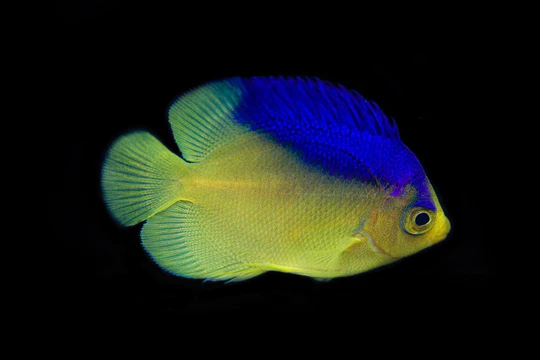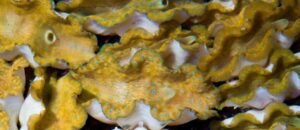Marine aquarium fish breeders have really been on a roll lately; we’ve seen a lot of popular fish families, such as angelfish, become increasingly available as captive bred. What’s especially cool is that some of the more rare and unusual (and perhaps delicate) angelfish species are significantly less prone to disease, are easier to feed and of course are far more amenable to a captive environment when obtained as captive bred specimens. The culture of the Colin’s angelfish by Biota is especially noteworthy here.
Colin’s angelfish natural history
The Colin’s angelfish (Centropyge colini), also known to some as the Cocos-Keeling angelfish, is an especially attractive species. Many hobbyists fall in love with its purplish blue markings over a bright yellow base color. Its caudal, anal and pelvic fins are also yellow. While some aquarists find them to be rather similar to the purple mask angelfish and venustus angelfish, the Colin’s angel is distinguished by a blue band that forms a saddle across the top, starting at the edge of the dorsal fin and extending to form a ring over the eye.
Centropyge colini is distributed throughout the Eastern Indian Ocean and the West Pacific Ocean (the Coos-Keeling Islands, the Philippines, the Solomon Islands, Fiji, Indonesia, Papua New Guinea as well as the Palauan and Ogasawara Islands). It inhabits deeper and dimmer fore-reef areas, preferring cracks and crevices in steep rocky slopes. It may be seen hanging upside down on the roofs of caves and overhangs. It occurs singly, in pairs, or in harems composed of 3-7 individuals. Males are just a little bigger than females.
Aquarium care
 At a modest maximum length of only 3.5 inches (9 centimeters), the Colin’s angelfish can be kept in smaller (though not nano) tanks–an absolute minimum volume of at least 30 gallons might in some circumstances suffice, though a 55-gallon or larger tank is best. On the other hand, because wild specimens in particular can be a bit trickier to keep, they are typically suggested for more experienced fishkeepers. Acclimation poses issues with wild specimens due to its collection from deep water habitats. Collection itself must be accomplished in a manner that prevents decompression related injury. Moreover, the species is known for being a much pickier eater than its cousins and may starve after first being introduced to captive conditions. Thus, the advantages of tank bred over wild specimens are more obvious with this angel.
At a modest maximum length of only 3.5 inches (9 centimeters), the Colin’s angelfish can be kept in smaller (though not nano) tanks–an absolute minimum volume of at least 30 gallons might in some circumstances suffice, though a 55-gallon or larger tank is best. On the other hand, because wild specimens in particular can be a bit trickier to keep, they are typically suggested for more experienced fishkeepers. Acclimation poses issues with wild specimens due to its collection from deep water habitats. Collection itself must be accomplished in a manner that prevents decompression related injury. Moreover, the species is known for being a much pickier eater than its cousins and may starve after first being introduced to captive conditions. Thus, the advantages of tank bred over wild specimens are more obvious with this angel.
Even so, given the species’ inherent characteristics, any Colin’s angelfish (captive bred or otherwise) should be afforded a stable, well-maintained aquarium system with excellent water quality, lower light levels and plenty of rocky hiding places (especially with shady overhangs). While it is good practice to dim the lights when introducing any new Collins angel, farmed specimens might adjust to higher light levels a bit faster. It’s worth noting that one should not mess around in the tank (algae scraping, aquascaping, etc.) while this shy, secretive and docile species is adjusting to its new environment.
As far as angelfish go generally, the Colin’s angel is mostly a peaceful species. In fact, because hyper-aggressive tankmates might intimidate a Colin’s angel during feeding time, it’s best to stock the aquarium with mellow species altogether; timid, shade-loving fishes like cardinalfish and dartfish are ideal here. Interesting, with some due caution, and in a larger tank, one might keep this fish with other angels; in nature, they are often found sharing their cave with multibarred angels (Paracentropyge multifasciata), regal angels (Pygoplites diacanthus) and other Colin’s angels. Wild specimens of these former two species are considered similarly temperamental to keep in captivity; Biota has managed to successfully culture both of those as well!
Colin’s angels are not exactly ‘reef safe’ fish. In truth, they are said to potentially nibble on some inverts, including corals and clams. They apparently are pretty safe with most soft corals, but should watched very closely in the presence in stony corals and (especially) zoanthids. Sea anemones and mushroom anemones are generally pretty safe with them.
Conclusion
Given the difficulty of obtaining, and the challenge of maintaining, wild Colin’s angels, the recent availability of captive bred stock from Biota is exciting indeed. Not traditionally encountered in the trade, this species can add quite a bit of interest to any soft coral-dominated (with lower light levels) or FOWLR system.
This species is notably more chilled out than many other members of its family, and therefore may be a good choice of angel for a peaceful tank. For sure, for those aquarists who dislike quarrelsome fish, its relatively sweet disposition will be much welcomed. In fact, it is rather reticent. While it doesn’t hide so much that it is frustratingly hard to observe, its occasional appearing and disappearing certainly makes it a lot more interesting to keep over time!
Considering all of this, when you factor in its vibrant colors and bold pattern, the Colin’s angel makes for an exceptionally desirable aquarium species!






Leave a Reply